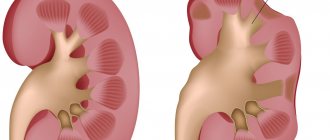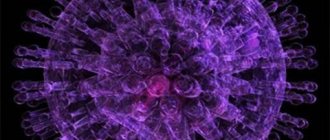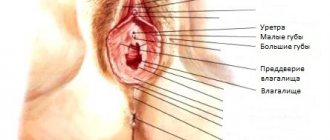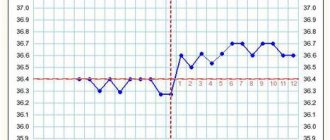The Zimnitsky test allows you to assess the concentration function of the kidneys, i.e. the ability of the kidneys to concentrate and dilute urine. To perform the study, the patient collects urine every 3 hours during the day (8 servings in total). In the laboratory, the amount and relative density of urine in each of the 3-hour portions, daily, daytime and night diuresis are assessed.
Normally, in an adult, fluctuations in the volume of urine in individual portions range from 40 to 300 ml; fluctuations in the relative density of urine between the maximum and minimum values should be at least 0.012–0.016 g/ml. Significant daily fluctuations in relative density are associated with the preserved ability of the kidneys to concentrate or dilute urine depending on the constantly changing needs of the body.
Normal renal concentration function is characterized by the ability to increase the relative density of urine during the day to maximum values (over 1020 g/ml), and normal dilution ability is characterized by the ability to reduce the relative density of urine below the osmotic concentration (osmolarity) of protein-free plasma equal to 1010–1012 g/ml. ml.
Indications for the study
- Signs of kidney failure;
- chronic glomerulonephritis, pyelonephritis;
- hypertonic disease;
- diagnosis of diabetes insipidus.
Conditions for sample collection and storage
Daily urine. Urine for research is collected in separate containers every 3 hours, including at night (8 servings in total).
On the day of the study, excessive fluid intake is not allowed, and diuretics must be avoided.
Defined parameters
- daily diuresis (total amount of urine excreted per day);
- daily diuresis (urine volume from 6 a.m. to 6 p.m. (1–4 servings));
- nocturnal diuresis (urine volume from 6 pm to 6 am (5–8 servings));
- the amount of urine in each of the 3-hour portions;
- relative density of urine in each of the 3-hour portions.
Reference indicators
- increased fluid intake;
- use of osmotic diuretics;
- kidney diseases (chronic renal failure, chronic pyelonephritis, polycystic kidney disease, distal tubular acidosis);
- diabetes insipidus;
- various forms of hypoaldosteronism;
- sarcoidosis, myeloma.
The amount of urine may increase (polyuria) with:
- Consuming large amounts of liquid;
- Eating foods that increase diuresis (watermelon, pumpkin);
- Kidney diseases (pyelonephritis);
- Diabetes mellitus;
- Dystrophies.
A decrease in the amount and volume of urine (oliguria) can occur with:
- Limiting fluid intake;
- Increased sweating;
- Diarrhea;
- Vomit;
- Kidney disease;
- Circulatory failure.
Urinary retention in the bladder can occur due to:
- prostate cancer and adenoma;
- prostatitis;
- narrowing of the urinary canal;
- obstruction of the bladder outlet by a stone.
The predominance of nighttime urine volume over daytime (nocturia):
- chronic pyelonephritis;
- chronic renal failure;
- heart failure.
Cessation of urine excretion (anuria) or excretion of no more than 50 ml per day:
- general condition disorders (shock, blood loss, decreased blood pressure);
- renal causes (poisoning with kidney poisons, transfusion of incompatible blood);
- disruption of urine flow from the kidney (stones, tumor).
Normally, daytime diuresis prevails over nighttime in a ratio of 3:1.
Daily volume measurements allow us to suspect problems in various organ systems.
For men and women, the daily diuresis rate is different.
This is due to differences in metabolic rate and hormonal processes.
In order for metabolic processes to proceed at a normal speed, it is necessary to consume at least 500 ml of liquid per day.
On average, the recommended amount is 1 – 2 liters.
Classification
In clinical practice, it is customary to divide oliguria into 3 large groups:
- Prerenal
. The most common type of oliguria. A drop in diuresis is associated with a deterioration in renal perfusion as a result of bleeding, excessive repeated vomiting, profuse diarrhea, etc. - Renal.
Oliguria is caused by kidney diseases: glomerulonephritis, acute tubular necrosis, interstitial nephritis, etc. - Postrenal.
A small volume of diuresis is associated with obstruction in the urinary tract due to urolithiasis and ureteral stenosis.
Daily diuresis of a pregnant woman
During pregnancy, a woman’s body receives a double load.
It does not occur immediately, but as the fetus grows.
An increase in the volume of circulating fluid leads to an increase in the need for water support.
This can lead to fluid accumulation in a woman's body.
Because of this, swelling develops.
During fetal growth, waste products enter the maternal bloodstream.
This forces a woman’s kidneys to work harder.
The volume of daily urine increases.
On average, the figure is 60–80% of fluid consumed.
Pregnant women note an increase in the frequency of urination.
This is due to fetal pressure on the bladder.
Volume of daily urine in infants
The metabolism of children is completely different from that of adults.
Children in the first month of life receive fluid from their mother's milk during breastfeeding.
Or dosed from a bottle - with artificial feeding.
As you gain body weight, the required amount of food increases.
Accordingly, the water load increases.
Up to six months, children tend to urinate frequently up to 20–25 times a day.
The daily volume of urine at this age ranges from 250 to 450 ml.
After 6 months, the child’s rate of weight gain decreases.
At the same time, the amount of food he receives is still growing.
But during this period of time, the baby gets acquainted with new food - complementary foods.
Taken together, the restructuring of the body leads to a decrease in the number of urinations per day to 15–16.
In this case, the daily volume of urine remains between 300 and 500 ml.
1.General information
In everyday life, while everything is more or less normal with health and well-being, we do not think about the meaning of this word - “normal”. And it is certainly not customary to discuss such physiological processes as, say, defecation or urination. At best, we know that we need to consume more liquid, that defecation should be carried out at least once every 1-2 days, but urination... according to need, according to the situation, if possible?
Meanwhile, the human body is a well-thought-out and evolutionarily tuned machine, the normal (i.e., effective and uninterrupted) functioning of which requires a normal sleep and rest regime, certain values of atmospheric pressure, ambient temperature, clean air and drinking water, and also a regular supply of nutrients. The removal of waste metabolic waste (residual products of digestion and renal filtration of blood), useless and harmful compounds, infectious toxins is just as important and necessary as all of the above.
There is not and cannot be a strict, uniform norm for everyone: too much depends on diet, age, individual metabolic characteristics and other factors. However, in medicine there are still criteria for normal urination, incl. concerning its frequency and volume. The kidneys of an adult produce, on average, about 1.5 liters of urine per day, and the normal frequency is 4-8 times a day (and no more than 1 time at night, otherwise nocturia is diagnosed - a symptom of night urination).
It is well known that too frequent urination (pollakiuria) does not occur for no reason and usually serves as a sign of one or another urological pathology. However, this does not mean that the opposite principle is true - “the less often, the better.” If the frequency of urination is less than the lower limit of the conditional norm (see above), and the daily volume of urine excreted is reduced to 400-500 ml (oliguria), this tendency usually indicates serious pathological changes, even if there are no other symptoms or they are mild .
A must read! Help with treatment and hospitalization!
Daily urine volume in children from 1 year to 7 years
After a child turns one year old, his body is already adapted to the environment.
The number of urinations is already 10–12.
Urine volume is from 500 to 600 ml.
The child's body still continues to grow rapidly.
But the pace is already significantly lower than that of an infant.
When a child reaches three years old, the number of urinations decreases to 7–9 per day.
This frequency will continue until the child reaches 7 years of age.
The only difference is the volume.
From 3 to 5 years, the daily volume of urine is from 600 to 700 ml.
After 5 and up to 7 years it increases to 650 - 1000 ml.
4.Treatment
Rare urination is always a symptom of pathology or at least an anomaly, but this symptom itself cannot be treated: of course, the disease, the etiopathogenetic root cause, must be treated. Accordingly, therapeutic strategy and tactics are entirely determined by the diagnostic results; In addition, prescriptions always take into account many purely individual characteristics, so it is impossible to outline at least in general terms all possible schemes of treatment prescriptions. It should, however, be emphasized once again: urinating too infrequently is just as serious a symptom as urinating too often, and in any case you need to take it seriously: consult a doctor as soon as the tendency becomes obvious, and not wait until much more severe manifestations and complications.
Daily urine volume in children from 7 to 13 years
At the age of 7 years, the child’s body has slow metabolic processes.
Until the age of nine, the number of urinations will remain up to 7–8 per day.
After 9 years of age, on average, urine output occurs 6 to 7 times.
At this age, the child can already consciously control the level of thirst and fluid intake.
Changes also occur in the daily volume of urine.
For children from 7 to 11 years old it ranges from 800 to 1400 ml.
After 11 years, the volume increases slightly to 1000 - 1600 ml.
Next, the child’s body is already undergoing changes that are associated with hormonal changes during puberty.
Excretory and metabolic processes acquire characteristics similar to those of an adult.
Reasons for changes in urine volume in pathologies
Increased urine output occurs in a variety of conditions:
- Increased body temperature;
- Hydronephrosis;
- Conn's syndrome;
- Psychosomatic disorders in children;
- Increased levels of parathyroid hormone;
- OPN.
A decrease in diuresis volume occurs for prerenal, renal or postrenal reasons.
Prerenal factors include processes that occur without involving the genitourinary system.
This may be a sharp decrease in circulating fluid, spasm of blood vessels due to shock conditions, or acute thrombosis of arteries and veins.
Cardiovascular pathologies can indirectly affect a decrease in daily urine volume.
Renal causes lie in the pathology of the kidneys themselves.
This may be direct damage to the kidney tissue or impaired circulation through the renal arteries.
The reasons may be:
- Glomerulonephritis;
- Vasculitis;
- Kidney injury;
- Toxic effect of substances;
- Pyelonephritis;
- Nephrotic syndrome.
The decrease in diuresis is based on dysfunction of the renal tubules.
Changes in the function of the ureters are among the postrenal factors of oliguria.
Ureteral obstruction can be caused by several reasons.
Blood clots, stones, and strictures can impede the passage of urine.
There may be external pressure from the uterus, which has increased, for example, during pregnancy.
Tumor formations can also put pressure on the wall of the ureter.
This leads to disruption of the outflow of urine from the kidneys.
Which doctor treats oliguria?
The first alarming symptoms of the development of a pathological process in the kidneys cannot be ignored. An urgent visit to the doctor is required. Oliguria is treated by a urologist or nephrologist. When making a diagnosis, consultations with an allergist, gynecologist, therapist, and dermatologist will also help.
Signs of violations
Changes in daily diuresis can be detected by interviewing and examining the patient.
Polyuria is characterized by a frequent urge to urinate.
In this case, a large amount of urine is released.
It has a light yellow color.
Can be almost transparent.
This indicates decreased urine density and low concentrating ability of the kidneys.
Manifestations of anuria include headache, dyspepsia, and itching of the skin.
There is an urge to urinate, but is often unsuccessful.
Voluntary urine output is not observed.
Sometimes there is no urge, and the patient is tormented by constant thirst.
Ishuria is accompanied by difficulties in performing the act of urination or its impossibility.
Feeling of heaviness and discomfort in the lower abdomen.
The appearance of swelling, weakness and drowsiness.
For pregnant women, when diuresis is impaired, protein appears in the urine.
This is the main sign that indicates problems with the urinary system.
There is a sharp jump in body weight and an increase in edema of the lower extremities.
Possible increase in blood pressure.
Urine is released frequently, in small volumes, and patients are thirsty.
Diagnostics
To find out the causes of oliguria, you must immediately consult a general practitioner, nephrologist or urologist. The doctor questions the patient in detail about the volume of urination, the presence of other complaints, previously diagnosed chronic pathologies, and the use of medications. The history of the disease is important - it is specified what preceded the appearance of oliguria.
A physical examination is also performed: measuring body temperature, blood pressure, checking Pasternatsky’s symptom, and the presence of peripheral edema. This information helps the specialist to differentiate the etiological factor and correctly direct the diagnostic search. For this purpose, an additional examination is prescribed:
- Blood tests.
In case of infections or autoimmune diseases, a general blood test shows signs of inflammation - leukocytosis and an increase in ESR. In a biochemical blood test, the concentrations of urea, creatinine, potassium, and C-reactive protein were increased. In case of systemic bacterial infections, the blood is tested for the content of presepsin and procalcitonin. The coagulogram often reveals signs of hypercoagulation - shortening of prothrombin time and APTT. - Urine tests.
With renal oliguria, signs of urinary, nephritic or nephrotic syndromes are revealed - proteinuria, hematuria, leukocyturia. To assess the concentration function of the kidneys or the presence of hidden renal pathology, functional tests are prescribed - Zimnitsky, Nechiporenko, Kakovsky-Addis. In the case of severe nephrological disease, microscopy of urine sediment reveals casts (granular, erythrocyte) and renal epithelial cells. - Immunological studies.
If post-streptococcal glomerulonephritis is suspected, the level of antistreptolysin (ASLO) is checked. To confirm rheumatological diseases, tests are prescribed for rheumatic factor and other autoantibodies - antibodies to DNA, to the cytoplasm of neutrophils, to topoisomerase. - Ultrasound.
Ultrasound of the kidneys can show various pathological signs - expansion of the pyelocaliceal system, compaction of the parenchyma, the presence of stones. Echocardiography in CHF shows dilation of the heart chambers, areas of myocardial hypertrophy, and a decrease in ejection fraction. - Urography.
Excretory urography allows you to establish the localization of a mechanical obstruction in the urinary system. Often prescribed to patients with urolithiasis. - Angiography.
Angiography is recommended to assess the patency of the renal arteries. A narrowing of the lumen of more than 50% indicates severe stenosis. - CT.
In case of oncological suspicion, a CT scan of the abdominal cavity and pelvic organs is performed to visualize a neoplasm of the kidneys or retroperitoneal organs. - Histological studies.
To confirm the presence of a malignant tumor, a biopsy is taken followed by pathological examination.
Also, for the differential diagnosis of prerenal and renal oliguria, the following is determined:
- urine osmolarity, incl. urine sodium concentrations;
- ratio of urine osmolarity to blood plasma osmolarity;
- the ratio of urea and creatinine content in urine to their level in plasma;
- partial sodium excretion.
Hemodialysis
What can affect the analysis result?
The amount of urine that is released per day can be influenced by certain factors.
The patient is recommended to keep a diary in which he will monitor the amount of fluid he drinks.
In particular, you can mark food and medicine in it.
During the test period, you should avoid eating diuretic products, pickles, and spicy foods.
Any medications that cannot be stopped should be discussed with your doctor.
It is worth noting the time you take medications in your diary, this will help avoid false indicators.
How is urine collection performed?
It is recommended to start collecting urine for the day at 6–7 am.
The first urination is not collected, starting from the second, urine is collected.
A container with a total volume of up to 3 liters is used for collection.
It may have graduations for more comfortable counting of quantities.
Starting from the second portion, the patient collects urine hourly into the indicated container.
Before each act of urination, hygienic treatment of the genitals is carried out.
To do this, use ordinary water; it is not recommended to wash with soap, as this will upset the alkaline balance.
The end of the analysis occurs exactly after 24 hours.
Before 6 p.m., daytime diuresis is considered, and after that, nighttime diuresis.
The quantity can be indicated on a special form.
Why is the first portion of urine not taken into account?
The first portion is not included in the analysis, so it can be used for other studies, if they are prescribed.
The reason is that night urine has a high density and concentration of minerals after sleep.
Features of daily urine collection in children
The analysis in children does not differ significantly.
For newborns and infants, whose urination is quite difficult to control, there are special pads.
These are plastic or cellophane bags with an adhesive surface.
Made from hypoallergenic materials and comfortable to wear and use.
Overlays of different shapes have been developed for boys and girls.
The adhesive surface is placed on the perineal area in the projection of the urethra.
The pad should be tightly fixed, then a diaper is put on the child.
The pads are changed every hour.
The entire contents of the bag are placed in a large container with a measuring scale.
You need to record the amount of each serving, then calculate the daily and nightly volume.
Collecting urine in children is a rather labor-intensive procedure; this study is usually carried out in a hospital.











